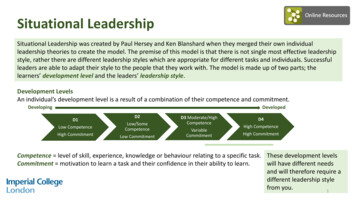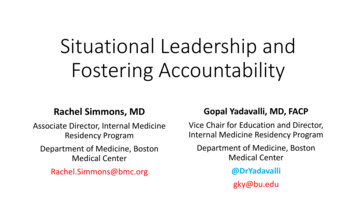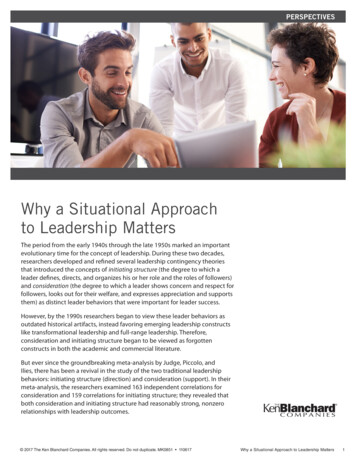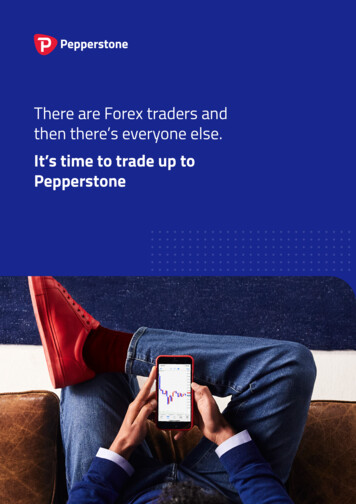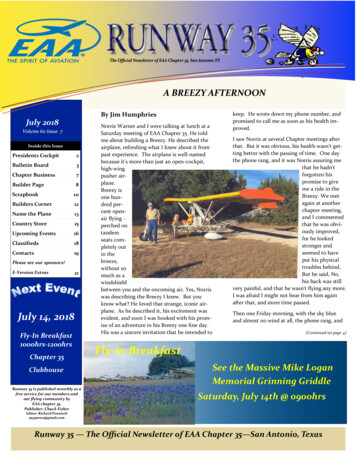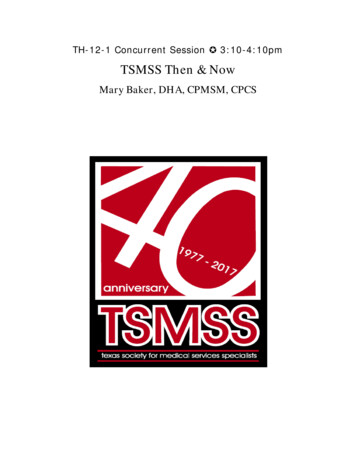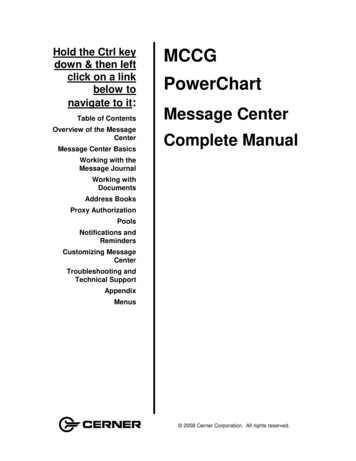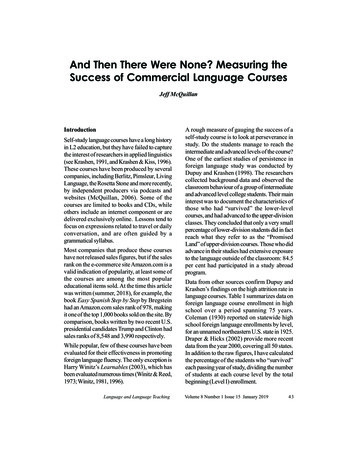
Transcription
SITUATIONAL LEADERSHIPRelevantT h e n,RelevantNow
SITUATIONAL LEADERSHIP :RELEVANT THEN, RELEVANT NOWAt its core, leadership is influence. Regardless of position,a leader is anyone who is able to influence others.Effective leadership is necessary to create and sustain ahigh-performing organization. Poor leadership can create ahost of issues that undermine a company’s performance,including mismanagement of resources, high turnoverrates and diminished returns on investment.With so much at stake in today’s competitive businessenvironment, organizations cannot ignore the importanceof developing their leaders and the impact it can have onthe business. Companies must equip their leaders withthe tools and resources they need to skillfully navigatethe demands of an increasingly diverse workforce andevolving global marketplace. And that starts with effectiveleadership development.The Situational Leadership Model transcends culturaland generational differences and equips leaders aroundthe globe with the skills necessary to drive behaviorchange and increase productivity. For more than 45 years,the Situational Leadership Model has enabled leadersat all levels of the organization to more effectivelyinfluence others.is based on the relationship between leaders and followersand serves as a framework to analyze each situationbased on: The amount of guidance and direction (task behavior)a leader gives The amount of socioemotional support (relationshipbehavior) a leader provides The Performance Readiness Level thatfollowers exhibit in performing a specific task,function or objectiveSituational leaders learn to demonstrate four core,common and critical leadership competencies:DIAGNOSE:Understand the nuances of the specific situationthey are trying to influenceADAPT:Adjust their behavior in response to thecontingences of the situationCOMMUNICATE:Interact with others in a manner they canunderstand and acceptADVANCE:Manage the movement toward higher performanceSituational Leadership helps leaderslearn how to think, before it teachesthem what to do.Situational Leadership , which stresses flexibility andsimplicity in execution, prepares leaders to addressthe most pressing challenges pervasive in today’swork environment.Dr. Sam ShriverORIGINAL SITUATIONALLEADERSHIP RESEARCHHISTORY & BACKGROUNDDeveloped by Dr. Paul Hersey in the late 1960s, SituationalLeadership is frequently referred to as “organized commonsense.” Dr. Hersey’s original Situational Leadership ModelBy definition, a model is a repeatable process. To addvalue, that model has to be leveraged on a consistentbasis. And to be used consistently, it has to be practicaland simple – without being simplistic.Copyright 2017, Leadership Studies, Inc. All Rights Reserved.2
The concepts, procedures, actions and outcomes derivedfrom the Situational Leadership Model are based ontested methodologies that are hands-on, real-world andeasy to apply. Dr. Hersey synthesized 50 years of researchon the behavior of leaders and followers to develop theSituational Leadership Model. The model provides aframework for leaders to match their behaviors with theperformance needs of the individual or group that they areattempting to influence. It is about adapting the directiveand supportive behaviors that leaders use to match thePerformance Readiness of others to perform specifictasks or functions.It seems odd to think about in this day and age, but thefirst 50 years of research on organizational behavior ingeneral and leadership development in particular weredisconnected, isolated and dispersed. Frederick WinslowTaylor’s findings with Scientific Management (1911) werein direct contrast with the conclusions reached by EltonMayo in the 1930s at the Hawthorne Electric Plant (HumanRelations Theory). Concurrent research at Ohio State(Ralph Stogdill, 1948) and Michigan (Coch-French, 1948)produced four-box configurations that identified a leader’sapproach as a function of providing some combinationof structure and/or support. Douglas McGregor’s (1957)research suggested the assumptions a leader made aboutfollowers was the driving force behind leader behavior(Theory X, Theory Y), while Abraham Maslow (1954), ChrisArgyris (1964) and Frederick Herzberg (1966) focusedtheir attention on the factors that contributed to humanmotivation and development.FIGURE 1Situational Leadership Situational Leadership changedthe way I managed people.HIGHInfluence BehaviorsRetired Senior Vice President, Biotechnology IndustryPartiSupportive BehaviorRelationship Behaviorlli n gcipSeatingS2S4S1These various (and often juxtaposing) conclusionscontributed to the foundational research that Dr. Herseyused to develop the Situational Leadership Model, firstpublished in 1969. After seeing this model create positiveresults for real-world leaders, Dr. Hersey concluded thatthere’s no such thing as a bad leadership style, they allwork! Leadership is about learning when to use each styleto effectively influence others.eli ngegatillTengS3LOWDLOWHIGHTask BehaviorDirective BehaviorHOW IT WORKSPerformance Readiness HIGHR4MODERATER3R2LOWR1Situational Leadership and Performance Readiness are registered trademarks ofLeadership Studies, Inc. Copyright 1972 - 2017. All Rights Reserved.In essence, leaders using the Situational Leadership Model (see Figure 1) start with the task and the personresponsible to perform it, then ask: How much task-specific knowledge, experience or skilldoes this person bring to the table?Copyright 2017, Leadership Studies, Inc. All Rights Reserved.3
Is this individual confident, committed and motivated toperform this task?Answers to these simple questions produce fourcombinations of ability and willingness (PerformanceReadiness ) that the leader can use as a starting point:R1“I need clear structure and direction.”depending upon the assessmentReadiness for the task in question:ofPerformanceS1Telling or guiding:The leader leverages his or her base ofexperience to make decisions, providedirection and create movement.S2R2“I am inexperienced, buthighly motivated, so I need bothencouragement and direction.”Selling or explaining:The leader clarifies decisions andrecognizes the enthusiasm of the followerin an effort to ensure understanding.R3S3“I have a good understanding ofwhat to do, but I need support.”Participating or involving:The leader and follower brainstormsalternatives in an effort to mutuallyestablish alignment.R4“I am motivated, competentand confident.”The leader then determines leadership styleas a function of:TASK OR DIRECTIVE BEHAVIOR:The extent to which a leader engages in defining roles,structuring activity and providing the what, where, when,how and, if more than one person is involved, who is todo what for a particular task.RELATIONSHIP OR SUPPORTIVE BEHAVIOR:The extent to which a leader engages in two-waycommunication, facilitates interaction andactively listens.Various combinations of task and relationship behaviordefine four leadership styles the leader can employS4Delegating or entrusting:The leader trusts the follower toleverage his or her base of experienceto complete the task.Leadership effectiveness depends on a leader’s ability toassess the Performance Readiness of an individual anduse the appropriate leadership style for the situation. Forexample, a new hire with little knowledge and experienceto perform a task would require more direction thanan employee who has several years of experience. If aleader entrusts a new employee to perform the task withlittle guidance, then the employee will likely exhibit poorperformance and ultimately feel frustrated and lost. Butif a leader provides proper detail and instruction, thenthe employee will feel empowered with the knowledgeto effectively perform the task. However, a leader cannotCopyright 2017, Leadership Studies, Inc. All Rights Reserved.4
simply provide direction without also providing somelevel of support. How much is some? It truly dependson the situation, which is precisely what the SituationalLeadership Model helps leaders to determine.BENEFITS OF SITUATIONALLEADERSHIP At its core, Situational Leadership provides leaderswith an understanding of the relationship between aneffective style of leadership and the level of PerformanceReadiness that followers exhibit for a specific task.With application across organizational leaders, firstline managers, individual contributors and even teams,Situational Leadership utilizes task specificity to serveas a mechanism through which leaders maximize theirinfluence-related impact.BENEFITS OF SITUATIONAL LEADERSHIP : Is a multidirectional model that can beleveraged for influencing up, down and acrossthe organizationare equally important to leading younger workers. Thisresearch has shown that both leaders and followers seeinfluence as a primary driver of goal-directed behavior, froma freshly-hired millennial to a nearly-retired baby boomer.Situational Leadership considers the entire lifecycleof a typical employee – from a new hire who needsdirection and support to learn new skills to a seasonedemployee performing tasks he or she has masteredlong ago. Regardless of an employee’s age or skill level,the Situational Leadership Model provides leaderswith a framework to appropriately engage and influencefollower behavior.INFLUENCE ACROSSCULTURAL DIVIDESSituational Leadership has been proven to upskill leadersaround the world, according to research conducted byAdvantis Research and Consulting. Whether a leader isbased in North America, South America, Europe, or Asia,the benefits of Situational Leadership remain consistent.Whether we’re talking about a manager in Brazil, Taiwan, orBelgium, the leadership competencies gained by practicing Creates a common language of performance Accelerates the pace and quality ofemployee development Is a repeatable process that your leaders can leverageto effectively influence the behavior of others Utilizes task specificity to serve as amechanism through which leaders maximize theirinfluence-related impact Addresses situations where people are developingor regressingINFLUENCE ACROSS GENERATIONSWhile there has been speculation that millennials havesignificantly different motivations in the workplacecompared to older workers, research by The Center forLeadership Studies and Training Industry, Inc. revealsthat the fundamental tenets of Situational Leadership As the baby boomer generationis exiting the workforce throughretirement, Situational Leadership has given our new and emergingleaders filling those roles an effectiveand efficient tool and thinking strategythat has decreased learning curvesand improved our training processes.Manager of Technical Training, Manufacturing IndustryCopyright 2017, Leadership Studies, Inc. All Rights Reserved.5
the Situational Leadership Model have been proven todrive business results such as market share, revenues,employee engagement and retention.The reason behind this versatility is because SituationalLeadership utilizes a common leadership language thatcan be applied across any boundary. Implementing themodel requires a leader to establish objectives, assessPerformance Readiness and determine the appropriateleadership style within the context of a given situation andwork environment. Even when attempting to influence thebehavior of international employees, where interactionsmay be impacted by differences in culture or language, aleader can apply Situational Leadership to navigate anygiven situation or interaction.As our organizations are becomingflatter and flatter, we see theimportance of influence standingout more and more. The informalnetwork is key to getting things donein many organizations and ours is nodifferent. There are many instanceswhere influence is what can drive thebusiness faster and more efficientlythan hierarchy.Director of Leadership Development, Biotechnology IndustryINFLUENCE ACROSS THE BUSINESSWhen analyzing influence across functional business units,leadership skills are most frequently used in positionsthat involve a high degree of person-to-person interactionboth inside and outside the organization. While influencetraining can benefit all functional areas across theorganization, influence skills are especially important toHR, sales, customer service and marketing departments.With so much at stake in today’s competitive businessenvironment, organizations need to ensure employeeshave effective leadership skills when interacting withcustomers, clients and vendors.Across multiple studies, research by The Center forLeadership Studies and Training Industry, Inc. has foundthat influence is important to leading employees across arange of industries, job roles and working arrangements,as well as across the full spectrum of knowledge workers.Whether a follower is employed in a highly complex job andworking remotely, or in a relatively basic job and part of atightly knit team, Situational Leadership is universal—and universally effective.DRIVING BEHAVIOR CHANGEA leader does not merely impact the behavior of anemployee through one or two interactions. Rather, havingpositive influence is a continuous process, requiringthoughtful application of influence-related strategy ona consistent basis over time. Situational Leadership recognizes that an effective leader, at any level, mustbe able to vary behavior not only as it applies to thesuccessful completion of the task at hand, but also toencourage employees to seize upon new challenges anddevelopment opportunities.Research by leadership expert Jim Collins suggests thatgreat leaders understand the importance of motivatingthe right people the right way to seize opportunities andbuild organizational momentum. By identifying the mostappropriate way to influence each individual, a leadercan elevate the performance of the entire company, oneemployee at a time.But what about when the company is goingthrough change? According to The Center forLeadership Studies an
The Situational Leadership Model transcends cultural and generational differences and equips leaders around the globe with the skills necessary to drive behavior change and increase productivity. For more than 45 years, the Situational Leadership Model has enabled leaders at all levels of the organization to more effectively influence others.
